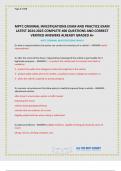Page 1 of 63
MPTC CRIMINAL INVESTIGATIONS EXAM AND PRACTICE EXAM
LATEST 2024-2025 COMPLETE 400 QUESTIONS AND CORRECT
VERIFIED ANSWERS ALREADY GRADED A+
MPTC CRIMINAL INVESTIGATIONS EXAM A
Q: what is required before the police can conduct an inventory of a vehicle? - ANSWER-lawful
impoundment
Q: after the arrest of the driver, impoundment (towing) of the vehicle is permissible for 4
legitimate purposes. - ANSWER-1 - to protect the vehicle and its contents from theft or
vandalism
2 - protect the public from dangerous items that might be in the vehicle.
3 - protect public safety where the vehicle, as parked creates a dangerous condition; or
4 - when the vehicle is parked on private property
Q: common circumstances that allow police to lawfully impound (tow) a vehicle - ANSWER-
abandoned vehicles
after driver's arrest when vehicle is traffic hazard
following OUI arrest
vehicle seized pending forfeiture
vehicles that are evidence of a crime
illegally parked vehicles when towing is authorized
Q: physical evidence - ANSWER-tangible evidence, capable of being perceived by sense of
touch.
(drugs, money, clothing, weapons, etc)
1
,Page 2 of 63
Q: Trace Evidence - ANSWER-transferred from one surface to another during physical contact
between people, places and objects.
often overlooked because of its microscopic size
(human hair, gunshot residue, soil, textile/wood/paint fibers)
Q: DNA evidence - ANSWER-biological evidence used to connect an offender conclusively to a
crime
human hair, tissue, bones, teeth, blood, salvia, semen, or other bodily fluids
Q: plastic fingerprint evidence - ANSWER-can be seen with the naked eye and left behind when
a person's finger leaves an indention.
can be found in soap, gum, wax, etc
Q: patent fingerprint evidence - ANSWER-can be seen with a naked eye and left behind when
material on fingers (blood, dirt, oil, etc.) is transferred onto a surface. they can be found on
paper, wood, cloth, plastic, metal and glass
Q: Latent fingerprint evidence - ANSWER-cannot be seen with the naked eye and left behind
when oil and sweat on finger skin are transferred to a smooth, non-porous surface. these prints
are seen when exposed to chemicals or light technologies.
Q: primary responsibility for first responders regarding trace, DNA and fingerprint evidence -
ANSWER-identify and protect the evidence until expert assistance arrives
Q: inner perimeter - ANSWER-Where the actual crime scene took place and contains physical
evidence
Q: how big is the inner perimeter - ANSWER-Should be at least twice the size as the actual
crime scene (can always be adjusted later)
2
,Page 3 of 63
Q: how many officers should guard the crime scene of an inner perimeter? - ANSWER-two
Q: who is allowed at a crime scene - ANSWER-authorized investigators and crime scene
investigators ONLY
Q: crime scene log - ANSWER-Document that tracks who visits and enters the crime scene and
for what purpose.
Q: information on a crime scene log - ANSWER-date and time log began
all persons inside/entering (victims/witnesses/suspects/police)
name and agency of people entering
entry date, time and signature
reason for entry
exit date, time and signature
Q: outer perimeter - ANSWER-Staging area for support personnel and equipment
Q: what is the use of an outer perimeter? - ANSWER--store equipment and supplies
-create a log of equipment assets and supplies to include date/location when deployed
-credentialed news media representatives
Q: purpose of a rough sketch - ANSWER-provide an overview of the crime scene and its
contents
Q: overall photograph - ANSWER-take one overall photograph of person to include their face
and other unique features (tattoos, clothing, jewely, etc.)
3
, Page 4 of 63
Q: mid-range photograph - ANSWER-take photos of injury 2-4 feet away while keeping other
distinguishing person features from overall image in view
Q: close-up photograph - ANSWER-take photos of each injury from less than 2 feet away. place
ruler next to injury to demonstrate size
Q: follow-up photograph - ANSWER-injury bruising and swelling may intensify 2-3 days later.
use the same protocols as overall, mid-range and close-up during follow-up photographs
Q: systematic searches - ANSWER-are determined by circumstances and individual officer
preference. more effective when done consistently
(top-down, front-back, left-right, outside-inside)
Q: lane search - ANSWER-Used to cover large areas quickly for missing people or evidence
(ex. looking for a red shirt in an open field)
-divide area into equal parallel lanes go in the same direction
Q: max width for lane and grid searches - ANSWER-six feet
Q: grid search - ANSWER-Cover areas more thoroughly for evidence that is harder to find.
Ex. 6" knife in wooded area
- Equal parallel lanes cross over each other at 90 degrees
Q: zone search - ANSWER-cover crime scenes that can be divided into obvious quadrants.
(ex. each room in a house could be a zone)
lane or grid methods can be used in each zone
4




